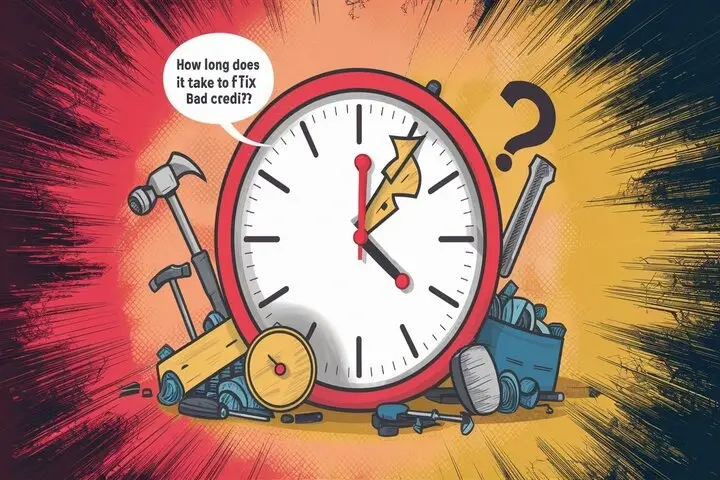
Similar to its name, bad credit is counterproductive as it feels like a constant weight attached to any endeavor. Holding a bad credit rating increases the cost of borrowing, the amount of deposit required, and the chances of being rejected for a loan, credit card, apartment, or job. They can be as numerous as they are extensive.
The good news is that credit repair is a reality that can be achieved if one applies efforts towards the process. However, to answer the question that seems to be on everyone’s lips: how long does it take to repair credit? Sustaining the right form of strategy, you will be in for a change as the scores take the upward swing and may as well take as short a time as several months. But to get a full reimbursement for all the credit repair services it may take at least 7 years.
How Long Does Credit Repair Take and Why?
That is why it is inadmissible to speak about credit repair in terms of years, not weeks or months, and it is high time to clarify this question. These key reasons shape your journey to good credit:
• Most Negative Credit Information Is Permanently Retained on Reports - Most negative credit information is retained on your reports for up to 7 years. That includes late payments, collections accounts, repossessions, and any ‘derogatory’ marks you would like to be removed. While some of these mistakes may be corrected for several years, they are still reflected in the scoring models for years.
• History Is Important to the Scores – FICO and VantageScore credit scores have your credit history as one of their significant components. This shows that the fee structure has a 15% input into the FICO score, which is given to the length of your history. In a way, as negative items deteriorate and any new positive lines deteriorate, the scores increase gradually. This means that time enables you to cover your tracks especially when you have gone wrong in the past.
Building Credit Takes Time New credit, especially installment loans and mortgage credit, can help build credit. But getting to the level of an ‘ideal’ customer in terms of account diversification and timely payments usually takes years. Attempting to add more new accounts to the mix too soon hurts the process. Patience pays off.
The good news? They do not necessarily reach rock bottom at 7 years and you’ll begin to see your scores move up, significantly if you know what affects your scores and their behavior.
These can be described as the first-line enhancements that are implemented within the first six months.
If your credit rating is low right now, then the length of the first six months is enough to add 50 to 100 points to your score if you dedicate yourself to credit repair. It is important to note that these are base-level increases and with specific planning and preparation, gains of anywhere between 75 to 150 points can be achieved depending on the patient’s starting point.
How is such fast change possible if full repair of the skeletal system takes years? Two key reasons:
1. Deleting Small Mistakes in a Short Space of Time Sky High Scores – Small mistakes such as incorrect personal details, having more than one account, fraudulent accounts, and medical bills that have been marked as disputed, can drag scores down significantly. Correcting these can significantly improve your credit score and reach 40 to 110+ points (or more) instantly.
2. Payment Plans With Collections Agencies And Creditors – With the help of payment plans with collections agencies and creditors, the late accounts are easily brought to “current” instead of being “past due.” The scores are raised by even low monthly payments and this is especially true in the first six months of the payment plan. FICO scoring models also provide a very high level of incentive to credit improvement actions in the recent past.
It is therefore apparent that in less than 6 months the correction of errors in combination with payment plan and/or financial changes yield a 50 to 150 point increase on the score. This is due to the positive momentum you have received that saw you gain creditworthiness.
However, it stagnates at around the 6-month mark, which is the start of the second half of training. Why? Time emerges as the next avenue to achieve further progress.
Why Improvement Stalls in the Second Half
Credit score increases at a slower rate from 6 months to 2 years or up to 24 months; this may rise by 5 to 15 points per month. However, once you get to 2 years or more of experience, both scores tend to increase at a faster rate. This lovers-then-rapid improvement has two explanations:
1. You have corrected the basics that you thought could easily be sorted- There were wrong reports; payment plans have been input; you have cleared balances; and sorted your spending and saving patterns. However, the harder task that lies ahead is the process of creating positive information.
2. Late pays and collections have not been around long enough to decrease scores – Late pays and collections accounts are relatively recent and therefore have a more significant effect on scores. It is manifested in the fact that gradually when the mice age over 24+ months, the sting gradually decreases.
At this slower pace, what you should be doing is making sure payments are being made according to plans, accounts are being kept current, balances on cards are low, and negative items getting older. Do not apply for credit which you do not require to to allow your credit profile to settle. Then...
The stabilization phase and the 24+ month mark bring faster improvements in the organization.
Instead, when negative items are older than 24 months, the negative impact on scores reduces month in, and month out. Due to their age, the occurrence of newer positive information begins to replace the previous faulty information.
This is particularly true once positive trade lines such as installment loans, or credit cards, mature to twenty-four months plus. Two year aged accounts along with the ideal type of credit are given high importance by FICO and VantageScore.
Paying off balances, carrying on payment schedules, and maintaining accounts in good standing create a positive scenario. In this way, when all the accounts become older than 24 months, scores can increase 25 points to 50+ points per month based on the approach.
During this rapid improvement period, it is possible to bring your scores up even more with small, deliberate strategic applications of new credit. However, do not overdo it and apply for too many forms of credit at one time, as this reduces your score improvements.
It took me about 7 years to repair my credit to the optimum level or as we would call it full credit repair.
Well, when do you get to the top of the state of this mountain? As mentioned earlier, the TEN to FIVE credit repair process restores credit scores from poor to excellent within 6-7 years. By this time or later, even severe blunders such as bankruptcies, foreclosures, and repossessions are brushed under the carpet.
Moreover, you have years to create an abundant garden full of good tradelines. Perfect payment records on installment loans and credit cards; long periods of 0 days delinquent can eradicate negative entries. Different forms of credit prove more creditworthy in the long run.
While everyone’s credit repair timeline differs based on their unique situation, this general path is common:
• First 6 months = 50-150+ points increase by correcting mistakes and presenting most recent accountability.
• Months 6 to 24 = Slow but steady mainly as negative items age
• Months 24+ = Gains of 25 to 50+ points monthly and are % consistently faster than the previous months.
• 84 Months=7 years = The maximum score improvement has been achieved.
The scores of 700+ that are possible once you are done with the credit repair process mean you can get the prime loans and rates that are only given to the most creditworthy consumers.
This means that you will be increasing your credit score gains every time you reach a milestone.
It is a long process to repair the credit but it will give the results in the end after the struggle. The best way to cope with periods of no activity when repairing credit is to familiarise yourself with the most frequent reasons for the slowdown. Thus, align major application, purchase, and financial moves within score gain patterns.
Above all, learn to champion your journey and keep looking ahead. The messages of such programs are clear: the consistent practice of good financial habits is rewarded over the months and years. Stay on the path of credit repair – the ‘tape’ will blink and you’ll be at the finish line!
Call now for expert credit repair services: (888) 803-7889
Read More:
How do I wipe my credit score?
How do I clean my credit report fast?
What credit score is needed to buy a $300K house?
What is a good FICO score to buy a car?
What credit score is needed to buy a $400,000 house?




